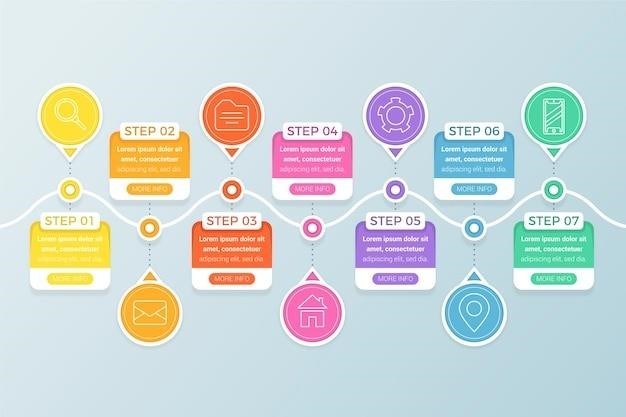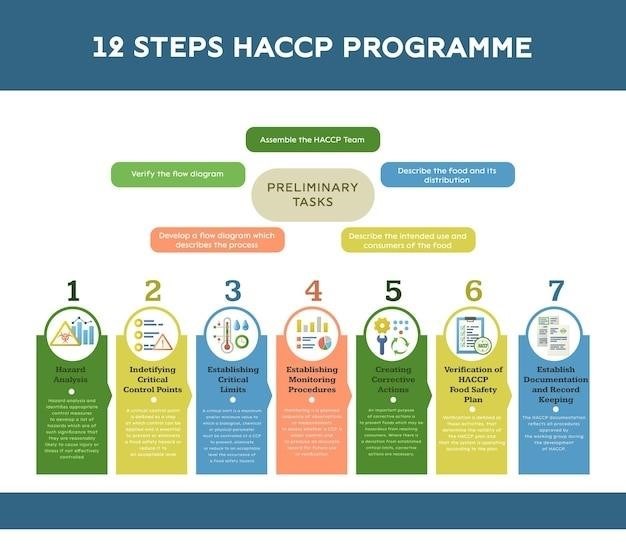The AVID Tutorial Process⁚ A 10-Step Guide
The AVID tutorial process is a structured and collaborative learning experience designed to help students deepen their understanding of academic concepts. It is divided into three phases⁚ before, during, and after the tutorial. These phases encompass ten specific steps, each designed to foster effective, rigorous, and collaborative learning.

Step 1⁚ Cornell Note Taking
The AVID tutorial process begins with a foundational step⁚ Cornell Note Taking. This method, named after Cornell University, is a structured approach to note-taking that emphasizes active engagement and efficient information retention. Students are encouraged to take detailed notes in their academic classes, using a specific format that divides the page into three sections⁚ the note-taking column, the cue column, and the summary section.
The note-taking column is where students record the main ideas and details presented by the teacher or from their textbook. The cue column is reserved for keywords, questions, or summaries that help students connect and recall the information. Finally, the summary section, located at the bottom of the page, serves as a concise review of the main points. This structured format allows students to actively process information, identify key concepts, and prepare for future study sessions.
Cornell Note Taking is not merely a passive recording of information. It encourages students to actively engage with the material, anticipate potential questions, and organize their thoughts in a logical and efficient manner. This practice lays the groundwork for the subsequent steps in the AVID tutorial process, ensuring that students have a strong foundation of knowledge and a clear understanding of their academic needs.
Step 2⁚ Pre-Work Inquiry
Following Cornell Note Taking, the AVID tutorial process moves into the crucial phase of Pre-Work Inquiry. This step requires students to proactively identify their points of confusion or areas of difficulty within the material covered in their academic classes. This process begins with a thoughtful review of their Cornell Notes, allowing them to pinpoint specific concepts that require further clarification or exploration.
The Pre-Work Inquiry is facilitated through the Tutorial Request Form (TRF), a dedicated document designed to capture the essence of the student’s academic challenges. The TRF serves as a communication tool, allowing students to articulate their specific questions and concerns in a structured manner. This step encourages students to take ownership of their learning by actively seeking clarification and support.
The TRF serves as a bridge between the individual student’s understanding and the collaborative learning environment of the AVID tutorial. By completing the TRF, students are encouraged to engage in a critical analysis of their own learning, identify areas where they need additional support, and prepare for a meaningful discussion with their peers and tutor during the tutorial session.
Step 3⁚ Tutorial Request Form (TRF)
The Tutorial Request Form (TRF) is the cornerstone of the AVID Tutorial Process, serving as a bridge between the individual student’s academic needs and the collaborative learning environment of the tutorial. This structured document encourages students to take ownership of their learning by actively identifying their points of confusion and articulating their specific questions and concerns.
The TRF is designed to guide students through a systematic process of self-reflection and inquiry. It prompts them to revisit their Cornell Notes, identify specific areas where they need clarification, and formulate focused questions that will be addressed during the tutorial. This step encourages students to think critically about their understanding and engage in a deeper level of analysis.
By completing the TRF, students are setting the stage for a productive and meaningful tutorial session. The TRF serves as a communication tool, allowing students to share their academic challenges with their peers and tutor in a clear and concise manner. This ensures that the tutorial addresses the specific needs of each student and fosters a targeted and effective learning experience.
Step 4⁚ Group Formation
The formation of small, collaborative groups is a crucial step in the AVID Tutorial Process. This carefully orchestrated grouping ensures that students are working in a supportive and engaging environment that maximizes learning opportunities. Group size is typically limited to 7 students or fewer, creating an intimate setting where each individual feels valued and has the chance to actively participate.
The composition of these groups is intentional, aiming to foster a balanced mix of skills and perspectives. This diversity ensures that students can learn from each other, share their unique insights, and build upon each other’s strengths. The group setting provides a safe space for students to express their understanding, ask questions, and challenge their own thinking in a supportive environment.
Group formation is not just about creating a convenient structure; it’s about fostering a sense of community and shared responsibility. By working together, students develop essential collaboration skills, learn to value different viewpoints, and build a sense of belonging within the learning process. This step sets the stage for a dynamic and productive tutorial experience where students can learn from each other and collectively achieve a deeper understanding of the subject matter.
Step 5⁚ Student Presentation
The student presentation marks a pivotal moment in the AVID Tutorial Process, shifting the focus from individual preparation to collaborative learning. This step empowers students to take ownership of their learning by presenting their point of confusion (POC) to their group. This presentation isn’t merely a recitation of facts but a chance for the student to articulate their understanding, highlight areas of uncertainty, and engage in a dialogue with their peers.
The presentation is typically structured as a 30-second speech, allowing the student to concisely summarize their pre-work inquiry and highlight the specific areas where they need further clarification. This concise format encourages focused communication and ensures that the presentation remains relevant and engaging for the group. The student presenter is encouraged to be clear, concise, and to use visual aids or examples to illustrate their POC effectively.
This step not only allows the presenter to clarify their own understanding but also provides a platform for the group to actively listen, ask clarifying questions, and contribute their own insights. The presentation acts as a catalyst for a deeper exploration of the subject matter, fostering a collaborative learning environment where students can build upon each other’s knowledge and collectively address the POC.
Step 6⁚ Questioning and Clarification
The questioning and clarification phase of the AVID Tutorial Process is where the collaborative learning truly takes center stage. Following the student’s presentation, the group transitions into a dynamic dialogue, with a focus on addressing the point of confusion (POC) and fostering deeper understanding. This step encourages active listening, critical thinking, and the development of effective questioning strategies.
The tutor plays a key role in facilitating this process, guiding the group’s inquiry and ensuring that questions are relevant, insightful, and contribute to the student’s understanding. The tutor’s role is not to provide direct answers but to encourage the group to work together to uncover solutions. Group members are encouraged to ask questions that challenge the presenter’s thinking, prompt further exploration of the subject matter, and help to identify any underlying misconceptions.
The goal of this step is not simply to resolve the POC but to develop a shared understanding of the subject matter. The group works together to analyze the presenter’s explanation, identify any gaps in knowledge, and explore different perspectives. This dynamic exchange of ideas not only helps the presenter to clarify their understanding but also broadens the understanding of the entire group, creating a more comprehensive and nuanced learning experience.
Step 7⁚ Group Debrief
The group debrief is a crucial step in the AVID Tutorial Process, serving as a reflection point for both the presenter and the group members. It’s a time to consolidate learning, identify key takeaways, and assess the effectiveness of the collaborative process. This step is designed to promote metacognitive skills, allowing participants to analyze their understanding, identify areas for improvement, and solidify the learning achieved during the tutorial.
The debrief begins with a review of the presenter’s initial point of confusion and the progress made during the questioning and clarification stage. The group discusses the key insights gained, the strategies employed, and the challenges encountered. This reflection process helps to solidify understanding and provide a framework for future learning.
Furthermore, the group debrief allows for a critical analysis of the collaborative process itself. Participants reflect on how effectively they worked together, the strengths and weaknesses of their communication, and the overall effectiveness of the group dynamic. This reflection promotes a culture of continuous improvement, encouraging students to refine their collaborative skills and maximize the learning potential of future tutorials.
Step 8⁚ Written Reflection
The written reflection serves as a critical component of the AVID Tutorial Process, offering students a platform to analyze their learning journey and synthesize their understanding of the subject matter. This step encourages deep thinking and self-assessment, fostering a deeper understanding of the material and promoting metacognitive skills.
In their written reflection, students are encouraged to revisit their initial point of confusion, articulating their understanding before and after the tutorial. They should detail the key insights gained, the strategies employed, and the challenges encountered during the collaborative process. This reflection allows students to identify areas where their understanding has deepened, pinpoint areas where further exploration is needed, and connect their learning to their broader academic goals.
The written reflection also provides an opportunity for students to evaluate their participation in the tutorial process. They can reflect on their role in the group, their contributions to the discussion, and their overall engagement with the material. This self-assessment encourages students to identify areas for improvement, promoting a culture of continuous learning and self-reflection;
Step 9⁚ TRF Submission
The TRF submission marks the culmination of the collaborative learning experience within the AVID Tutorial Process. Students are required to submit their completed Tutorial Request Forms (TRFs) to their teacher or tutor, signaling the end of the formal tutorial session and initiating the next stage of learning. The TRF submission serves multiple purposes, acting as a tool for evaluation, feedback, and accountability.
Upon submission, the teacher or tutor reviews the TRF, evaluating the student’s understanding of the subject matter and their engagement with the tutorial process. This review provides valuable insights into the student’s progress, highlighting areas of strength and identifying areas where further support might be necessary; The feedback provided on the TRF guides students toward a deeper understanding of the material and encourages them to refine their learning strategies for future tutorials.
The TRF submission also serves as a record of the student’s participation in the tutorial process. This documentation ensures accountability, as students are expected to engage actively in the collaborative learning experience. The TRF submission helps to track student progress, provide feedback, and foster a culture of continuous improvement within the AVID program.
Step 10⁚ Class Debrief
The class debrief concludes the AVID tutorial process, providing a space for reflection, synthesis, and application of the knowledge gained. This step is crucial for solidifying understanding and promoting a deeper level of learning. The debrief allows students to share their insights, discuss their learning experiences, and connect their newfound knowledge to real-world applications.
During the debrief, students and the teacher engage in a facilitated discussion, revisiting the key concepts explored during the tutorial. This process reinforces learning, allowing students to articulate their understanding and address any remaining questions or points of confusion. The teacher can provide further clarification, offer additional insights, and connect the material to broader academic themes.

The class debrief also encourages students to reflect on their own learning process. This reflection helps students identify their strengths and areas for improvement, prompting them to consider how they can apply the strategies learned in the tutorial to their future academic endeavors. The debrief ultimately fosters a growth mindset, empowering students to become active and engaged learners.



